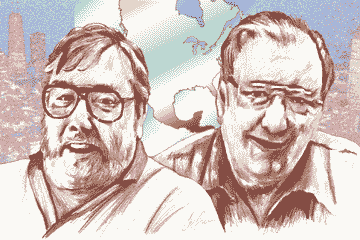INTERVIEW
Tales Of Professional Daytraders
Bob And Don Bright Of Bright Trading
by John Sweeney
Bored in retirement from exploiting the Standard & Poor's OEX options spreads, Bob Bright got back into trading in 1992 by forming Bright Trading with partner Edward Franco as an off-floor venue for professional traders -- that is, licensed traders. Starting from a single office in Chicago, they offered traders top-drawer market access for as little as 5% of their former overhead plus trading costs of less than a penny a share.
The concept was a hit: the combination of lower costs and local offices proved irresistible to the professional traders, and so, Bright went on to open similar offices around the country, currently up to 32. To get a take on what a professional daytrader does, Interim Editor John Sweeney of STOCKS & COMMODITIES called Bob Bright to find out, getting his brother Don, whose title is trader and director of education for the firm, in the bargain, in a telephone interview conducted on March 14, 2000. Bob Bright's part of the conversation is noted as "BB" and Don Bright as "DB."
ILLUSTRATION BY CARL GREEN
How did you start all this up?
DB: Bob had retired to Las Vegas in the late 1980s. I stopped trading in 1989 on the Pacific Coast and went on to do some other ventures, building and marketing electric cars. But in 1992, Eddie Franco and my brother decided to set up shop, and so they did. They officially formed Bright Trading, and by 1994 they had five offices.
What's the point of the offices?
DB: To give people a place to trade. When Bob and Ed were getting started with this venture, if someone wanted to trade as a professional, they had to go to Chicago or New York, or San Francisco, or Los Angeles. Now, because of the technology, we are able to duplicate the environment of a trading floor, but we don't have to be there; we can do it 3,000 miles away. Having the equipment and -- seriously -- the atmosphere makes a big difference.
What did you do?
DB: The more people we could get under one roof, the better, to simulate a trading environment. We ended up with 50 to 60 people in our Chicago office, but then we had people who lived in Northbrook, which is a suburb north of Chicago. So we opened an office there. Then one of the other guys wanted to move someplace else and we ended up opening another office there. What we ended up doing was expanding to 32 offices by allowing people who are experienced, qualified managers within the firm to "go home again" if they want, to Cincinnati, or Cleveland, or wherever.
When did you come on board?
DB: In late 1994 or early 1995, when Bright Trading had five offices. I had been a trader before, but I had had marketing experience in the previous five years selling electric cars to major players in Hollywood. So I was able to utilize those contacts, and I discovered I had a knack for getting the word out to people without running up advertising bills. In a business like this, you almost shy away if someone's advertising too much, because it looks like some kind of get-rich-quick scheme.
How did you do it, then?
DB: We were able to grow the office by getting the word out on the Internet. Just by using some subtle, low-key advertising, we were able to attract a lot of professional traders from the trading floor. In Los Angeles, for example, to be on the floor of the Pacific Stock Exchange cost somewhere between $12,000 and $20,000 a month to go down there and risk their money.
Between $12,000 and $20,000 a month? For what?
DB: To have a post on the exchange.
And that's not trading cost?
DB: Nope. That's just overhead. So when we offered it for $600 a month, which is what our rent is, to cover the equipment, we attracted a lot of the better traders.
They felt your atmosphere and your trading situation was as good as being on the floor?
DB: Absolutely. We have the same access to the market that the top Merrill Lynch traders would have. We use Ready Plus. We have First Alert, and Track Data for datafeeds. To duplicate what we give each trader for $600 a month, even with the costs coming down, would cost someone else between $1,000 and $1,500 a month, even to try to do it at home.
We allow remote trading, but we discourage it. It's fine for investing; it's fine for the person making an occasional trade, but if you are really going to do this as a profession, you need to be in an atmosphere where other people are doing it. Otherwise, it's what we call "hermit trading."
Why's that?
DB: When you are trading at home and you see a great opportunity, you hesitate that nanosecond, thinking, "What am I missing?" and by that time, one of our traders has got it. That kind of speed is imperative to the type of trading that we do.
The bull market has made experts out of a lot of people who aren't that well trained or educated. When the market goes straight up 4,000 or 5,000 points and all you do is buy and hold, everyone thinks they're traders. Well, they're not. -- Bob Bright and Don Bright
Excerpted from an article originally published in the June 2000 issue of Technical Analysis of STOCKS & COMMODITIES magazine. All rights reserved. © Copyright 2000, Technical Analysis, Inc.
